ArtisticGraver, ArtistGraver and ArtGraver Machines and Handpieces
Lindsay Engraving & Tools - When quality means everything. In Your work and Ours!
Family Owned! 46 Year History Tools Designed and Made in USA!
Follow on Instatgram
Hand Engraving Artist & Tool Maker
Click to enlarge photos
History -- Lindsay's tools are from a culmination of 46 years of engraving and tool making by Frank and Steve Lindsay. In 1975, at the age of 17, Steve began to learn hand engraving with his father who is a watchmaker and jeweler. Frank became friends with John Rohner and James (Bruce) Meeks. At that time he purchased John Rohner's invention called a Gravermeister from John in Boulder Colorado. John's invention was the world's first pneumatic engraver. John Rohner was a supporter encouraging Steve to continue learning. Above is a book John signed in 1977 which was an inspiration to Steve.
In 1977, after graduating from high school, Steve enrolled in the same Nebraska tech college that his father attended studying watch making. Steve enrolled in machine tool and die on the recommendation of John Rohner. The college and super instructors (i.e. Alan Carter) allowed students to use the school's machine shop for personal projects in the evening. Taking that opportunity, Steve created several new hand pieces for the Gravermeister that he was using. The new hand pieces were palm-sized rather than long. This was beneficial for smaller, detailed engraving as well as providing improved control. In 1979, Frank designed an electronic circuit to oscillate and adjust the speed of a solenoid valve. Air was run through the valve to produce blow-pulses rather than suction-pulses. Frank made two of the machines. Steve used the school's machine tools to build various hand pieces for Frank's adjustable positive pulse generator. In an interview for the December, 1981 NebraskaLand magazine, Frank's machine was mentioned and a picture of it can be seen on the back corner of the engraving bench on page five of the article. NEBRASKAland.pdf It is the gray box in the right back corner of the bench. The hand pieces hidden for the article and from the public for years, and until they were posted on the internet in 2006. At the left is a picture of three positive pulse gravers made in 1979 for Frank's machine.
Steve found that the limitation to his father's design and other designs on the market be that air or electric is that they depend on a spring in the handpiece. The spring in these designs creates a limited power band. They have an adverse effect of loss of power, or a complete absence of power when the piston floats, caused by the pulses giving insufficient time for the spring to return. This is caused by the frequency of the air or electric pulses being too fast and/or by too much air pressure or current in each pulse.
Pulse Electromagnet graver
Through the mid and late 90's Steve worked on designing, and attempting to create a new device that would give an even wider range of power and impact strokes, without sacrificing the finesse and control my father built into his engraving machine. The venture led Steve to research to directly using the solenoid as the handpiece itself using the 555 timer IC circuit from Frank's 555 IC timer pulse generator machine. The handpiece was an airless electromagnet graver. The graver worked for the fine engraving, but had limited power at the top end (or if a heavier spring is used be the same loss of low end power occurred similar to the air pulse designs giving the same limited power band). Problems with the pulse electromagnet engraver were -- The handpiece becomes hot in your hand. The heavier the engraving done the hotter it gets. Another problem was magnetism. Watches and magnets do not get a long. Steve's father is a watchmaker/jeweler and Steve was taught that magnets have no place in a watch-making shop. Since the graver was an electromagnet it would magnetize gravers, especially HSS and M42 gravers, as well as other tools it got near it magnetized.Finally, by accident, Steve happened on the current design. The design Steve was attempting to build then was a two valve system working together as one in a forward direction, but he found the mechanism ran better backwards. The challenging aspect was to create an impact pulseless engraver that did not require either an air pulse or an electric pulse generator taking up space on the bench, and that would oscillate with the smallest whisper of air required for microscopic engraving shading work and yet be able to muscle out the background around a scroll design when used with much greater air pressure. Since 1999 the AirGraver has been working for Steve's work as well as engravers and jewelers world wide.
After machine tool & die school in 1979, Steve continued to engrave by day while working second shift in the tool room of a Nebraska manufacturer. After regular hours there, he used their machine tools and continued to refine engraving tools. He also made two positioning vises for his father and himself for engraving under. The diamond microscopes Frank used in his jewelry store. In 1980 after the tools were refined and efficient, Steve quit the factory machine tool job and began full time engraving. Another friend of Frank's, Lynton McKenzie, recommended Steve attend the knife makers' guild show in Kansas City in 1980.
He took the top side of this linked 9mm Browning to the show. Lynton was at the show and took him from table to table to introduce him to knife makers and his collectors. Knife markers such as Buster Warenski, Steve Johnson, Steve Hoel, Ron Lake, Jim Hardenbrook and Jim Ence were at the show. From those introductions, knife makers and collectors gave Steve engraving jobs. (some can be seen at LindsayEngraving.com ). For the next few years, Frank made more improved hand pieces with his lathes and milling machines that Steve then used for his engravings. In 1984 or 1985 James Meeks came by to say hello and visit. He was working on his second book then and brought along many white plastic plates. He explained the surface was white but when cut into, the lines showed black. He had engraved them with various scrolls and example designs. He explained he was engraving this plastic because the engraving would photograph well for the book. After that visit Don
Glaser Sr. called and said that Meeks really enjoyed seeing my palm sized powered graver. It was an awkward phone call because Steve did not show Meeks his hand piece during his visit. Steve did receive a phone call while Meeks was visiting and he was left alone at the bench for a short time. He must have found the hand piece. It was interesting because after that Mr. Glaser brought out a new smaller hand piece that had a plastic mushroom handle on the butt, unlike the hand pieces they were making that were long and straight with a handle midway rather than at the end. It did not matter since Steve was not in the tool business at that time, but only engraving for collectors. In 1987 Frank and Steve did some engraving projects together. They produced five engraved folding knives. Steve drew the outlines of the knife designs and Frank made and set the diamonds, and Steve then engraved them. Frank's knives had hidden watch screws and wedges and would come apart allowing the inside surfaces as well as the outside ones to be engraved. The five pieces were called Lindsay-Lindsay and priced up to $110,000.
Lynton Mckenzie and Steve engraved a SCI Safari Club International rifle project together. David Miller was the maker, Lynton engraved the rifle and Steve did the accessories and a Steve Hoel folding knife that were cased with the rifle. The piece sold at auction for $210,000. There is a photo of the accessories at link. Click the photo there to enlarge, link.
Lynton had also been engraving Gene Clark's watches. When Lynton became sick in early 1998 he recommended to Gene that Steve engrave them. Steve engraved three of Gene's watches. An improved design was completed while working on the second one. That second one was auctioned at Sotherby's and sold for $62,500. Lindsayengraving.com/Clark.htm Through the years the tool continued to be improved. There is a video of one of Gene's watch faces being engraved in the above link.
Some of Steve's hand engraved art
 |
 |
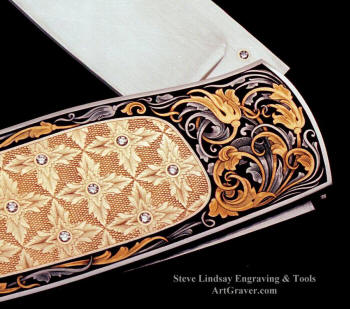 |
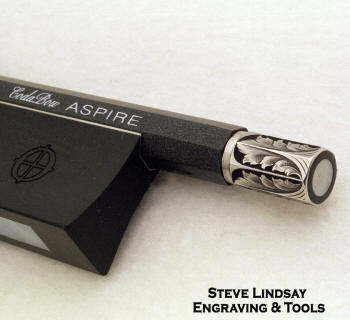 |
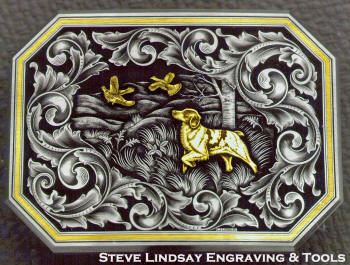 |
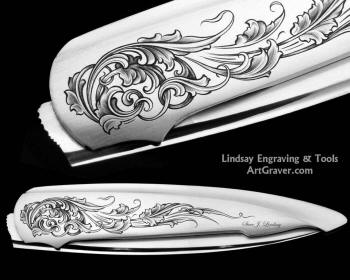 |
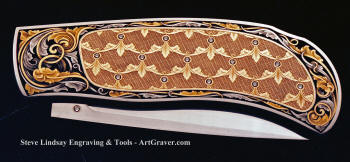 |
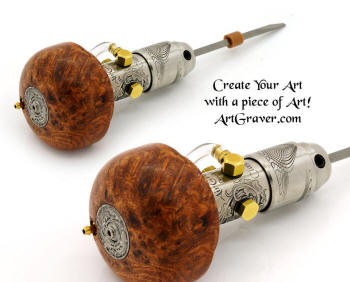 |
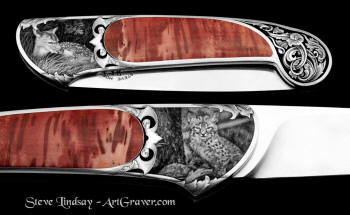 |
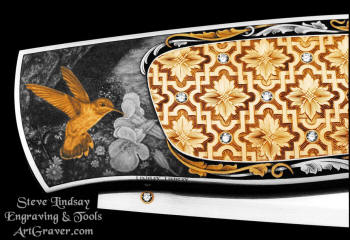 |
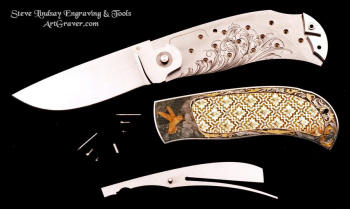 |
 |
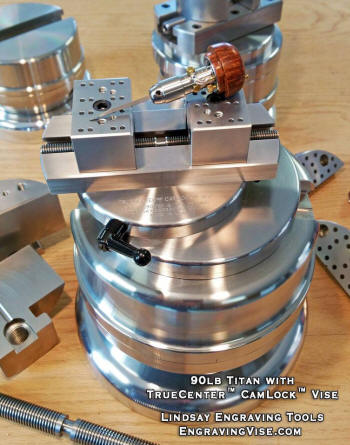 |
 |
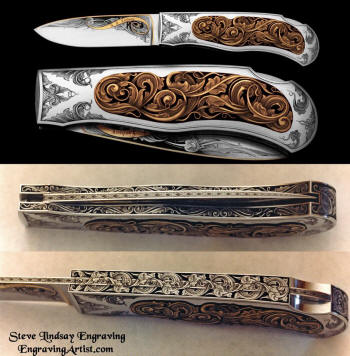 |
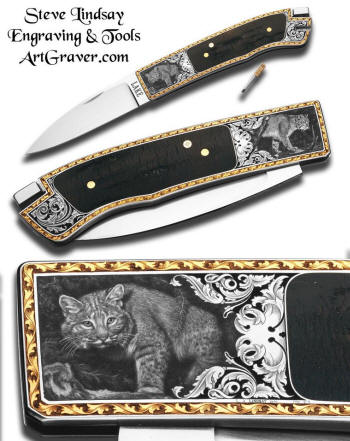 |
 |
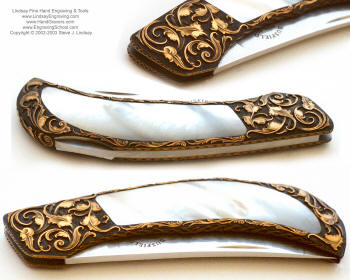 |

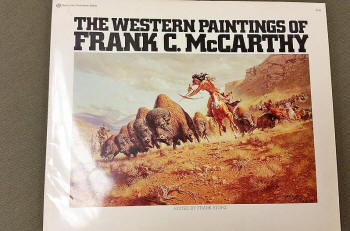
.png)

_small.png)